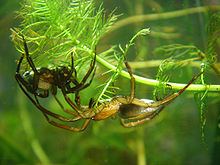- Diving bell spider
-
Diving bell spider or The water spider 
Female (on left) and male Scientific classification Kingdom: Animalia Phylum: Arthropoda Class: Arachnida Order: Araneae Family: Cybaeidae Genus: Argyroneta
Latreille, 1804Species: A. aquatica Binomial name Argyroneta aquatica
(Clerck, 1758)Synonyms [1] Araneus aquaticus
Aranea aquatica
Aranea urinatoria
Aranea amphibia
Clubiona fallaxThe diving bell spider or water spider, Argyroneta aquatica, is the only species of spider known to live entirely under water.
Argyroneta aquatica is found in northern and central Europe and northern Asia up to latitude 62°N. It is the only spider known to spend its whole life under water. However it breathes air, which it traps in a bubble held by hairs on its abdomen and legs.[2]
Females build underwater "diving bell" webs which they fill with air and use for digesting prey, molting, mating and raising offspring. They live almost entirely within the bells, darting out to catch prey animals that touch the bell or the silk threads that anchor it. However they have to surface occasionally to renew their personal air supplies and those of their webs. Males also build bells, but these are smaller and the males replenish their bells' oxygen supply less often. The males also have a more active hunting style. Although they are better swimmers than females, they prefer to cling to silk threads or underwater vegetation while moving.[2]
Very unusual for spiders, males of this species are about 30% percent larger than females, possibly because their more active hunting style requires greater strength to overcome the resistance of the water and to counteract the buoyancy of their mobile air supplies. The sizes of females may be limited by the amount of energy they put into building and maintaining their larger bells.[2]
The spider web can serve as underwater gills for the spider exchanging carbon dioxide with oxygen in the surrounding water.[3]
The appearance of the diving bell gave rise to the genus name Argyroneta, from the Greek "argyreios" (αργυροειδής), meaning "silvery", and "netos" (νήθωσ) meaning in context: "spun".[4] However, frequent replenishment at the surface is unnecessary in well-oxygenated water, because the structure of the bell permits gas exchange with the surrounding water: oxygen is replenished and carbon dioxide expelled by diffusion. The process is driven by differences in partial pressure and relative solubility in water, of nitrogen, oxygen, and carbon dioxide. In summary, as oxygen in the bubble is used up, more can diffuse in, whereas as carbon dioxide accumulates, it dissolves in the water and is lost. This system has been referred to as "the water spider's aqua-lung of air bubbles," but it is actually more advanced than the real Aqualung, which needs to be refilled frequently with compressed air, not having the option of continuous exchange of oxygen and carbon dioxide with the gases dissolved in the water.[5]
The prey of these spiders includes various aquatic insects and crustaceans. Their fangs are robust enough to pierce human skin and the bite is said to be quite painful, causing localised inflammation and feverish symptoms.[6] The spiders themselves fall prey to frogs and fish.[7]
Prior to mating, the male constructs a diving bell adjacent to the female's before spinning a tunnel from his bell to hers and then breaking through her wall to gain entrance.[7] Mating takes place in the female's bell, after which the female spider lays from 30 to 70 eggs there.[7]
The spider is found in ponds near the palaearctic region, which includes Europe, northern Asia, and Africa north of the Sahara desert.[citation needed] It lives for approximately two years.[citation needed] It is velvet-grey, although the trapped air around its body gives it a silvery appearance.[citation needed]
References
- ^ Norman I. Platnick (March 27, 2010). "Fam. Cybaeidae Banks, 1892d: 95". The World Spider Catalog, Version 11.0. American Museum of Natural History. http://research.amnh.org/iz/spiders/catalog/CYBAEIDAE.html. Retrieved August 30, 2010.
- ^ a b c Schütz, D., and Taborsky, M. (2003). "Adaptations to an aquatic life may be responsible for the reversed sexual size dimorphism in the water spider, Argyroneta aquatica" (PDF). Evolutionary Ecology Research 5 (1): 105–117. http://www.zoology.unibe.ch/behav/pdf_files/Schuetz_EvolEcolRes03.pdf.
- ^ J. Exp. Biol.: 2175–2181. 2011.
- ^ Jaeger, Edmund Carroll (1959). A source-book of biological names and terms. Springfield, Ill: Thomas. ISBN 0-398-06179-3.
- ^ Flynn, M. R.; Bush, JOHN W. M.: "Underwater breathing: the mechanics of plastron respiration"; J. Fluid Mech. (2008), vol. 608, pp. 275–296. Cambridge University Press doi:10.1017/S0022112008002048
- ^ Ross Piper (2007), Extraordinary Animals: An Encyclopedia of Curious and Unusual Animals, Greenwood Press.
- ^ a b c Chandramita Bora. "Water Spider". http://www.buzzle.com/articles/water-spider.html.
External links
Categories:- Cybaeidae
- Animals described in 1758
Wikimedia Foundation. 2010.
